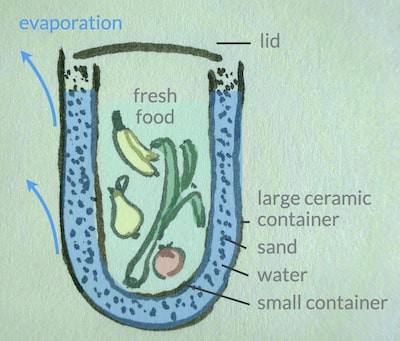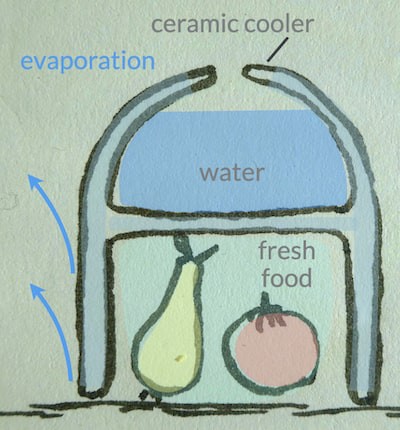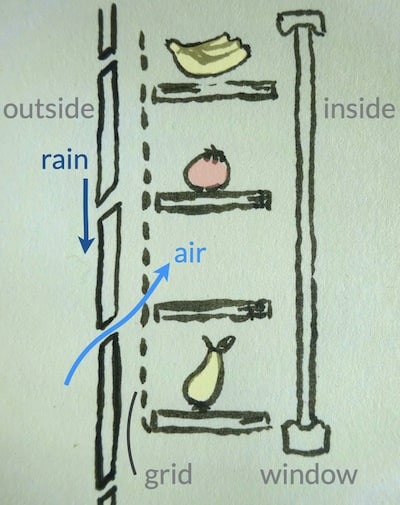An outdoor pantry, accessible from inside, to replace the fridge in winter
ˬ˯vᐯ˅ˇ ⌣ ᘁ᥎ᨆ⏝ࡍ⩗ᨆ⌣˘ˬ᥎ᐯᨆ⌣ᘁ⩗ᨆࡍ˯
This post is from Mésange, my weekly ‘popup’ newsletter, from October 2022 to March 2023. < Previous | Next >
I think it was around 1998 when I discovered “the desert fridge”, in the first issue of Jonas, an ecology magazine. There was only one issue of this magazine.
The ecological urge was already known for a long time, but it was apparently still too early to make a magazine out of it. And, as quickly as it appeared, poof, Jonas disappeared. Too bad, I really liked this first issue!
Today, ecology magazines abound, and the desert fridge has become a classic1.
The principle? Thanks to the evaporation of the water contained between two ceramic containers, the inside of the smaller container is kept cool.
This story through my voice (6:20 min)
For these first podcast episodes, I’ve set a rule for myself: I publish them without cuts, without edits, including my hesitations and mistakes. It’s raw, as if you were with me!
right-click on the bar to download the mp3 | view all podcasts
The desert fridge
Inspired by the reading of Jonas, I tried to adapt the concept.
I imagined a kind of ceramic cooler in a dome shape, which we would lift to take or put food.
In order to keep this dome moist, I thought of a water tank integrated on the top. I then made this first fridge, very small, out of clay.
Very excited, I had prepared a campfire in the garden to fire it up. My cooler, while firing, cracked. I could never test it.
The outdoor pantry
But yesterday, to take revenge, I made my second fridge! For Paññā, our tiny house lab.
It’s not a desert fridge, it’s rather a temperate fridge. It’s so simple, in fact, that the word fridge is probably not appropriate! Let’s just say call it a pantry. A storage space outside the tiny house, but accessible from inside2.
Paññā’s pantry is just wooden shelves behind a window.
Since the shelves are only 20 cm deep (~8 in), we can see everything. No risk of letting food spoil, and no need to install a lamp inside.
This pantry is located in the “cold column” of Paññā, that is, the northeast corner, protected from the Sun.
This column contains the downspout pipe for rainwater, a space to receive a future rainwater tank, and the pantry.
The cold column door on the north side is louvered, that is, it allows air to circulate. But the wood slats are also beveled, that is, cut diagonally, to keep out the rain.
So, does this fridge work?
These days, it’s 10-15 °C outside (50-60 °F), and almost the same temperature in the pantry, more or less one degree. Even when heating Paññā to 25 °C last night (77 °F), I couldn’t get the fridge to warm up. So it’s working pretty well!
For sure, it’s not a fridge that will maintain the temperature at 4 °C all the time (~40 °F). Here, it will vary, depending on the weather. It’s another lifestyle.
And when it freezes outside?
Last winter, here in Burgundy, I noticed that some spots freeze much later than others. These are the areas that are not directly facing the sky, like under a tree; or that receive radiation from an object, like near a wall.
Our pantry is not directly under the sky, and it also benefits from the heat leakage of the tiny house, so it should be protected from freezing.
But I still thought of two additional options to test when winter will be well established:
- Adding some sort of insulation against the grid to protect the pantry from extreme cold.
- Adding elements in or around the pantry, like bricks, to increase the thermal inertia.
And in summer?
For summer, the goal changes. We aim at maintaining a lower temperature in the pantry than outside. This requires hence some adaptations.
For that, I have a couple of ideas to test, but I’ll deal with them next spring!
Finally, the bucolic touch…!
However, there is one strategy that could work in both winter and summer, and is therefore worth testing now: moss!
In winter, on trees, moss protects the trunk from the cold like a blanket. In summer, it refreshes it, thanks to evaporation, like in the desert fridge.
So, I have just tagged the door of the cold column with a moss-based paint3. I don’t know about you, but I can’t wait to see how it will grow…
- The low-tech lab, for example, offers a tutorial for making a desert fridge.
- The low-tech lab offers another tutorial for making a pantry. They detail 4 environments adapted to different types of food.
- I made a mixture using moss from the walnut tree right next to Paññā. When the mixture is a little creamy, it is easy to spread with a brush. The moss should start growing in the next few weeks if I can keep the wall a bit moist. For example, here is a recipe and more explanation.
- Previous experiment (6/26) : Let’s try to think like an ecosystem. An essay on ‘invasive plants’
- Next experiment (8/26): A contemplative exploration of acorns


